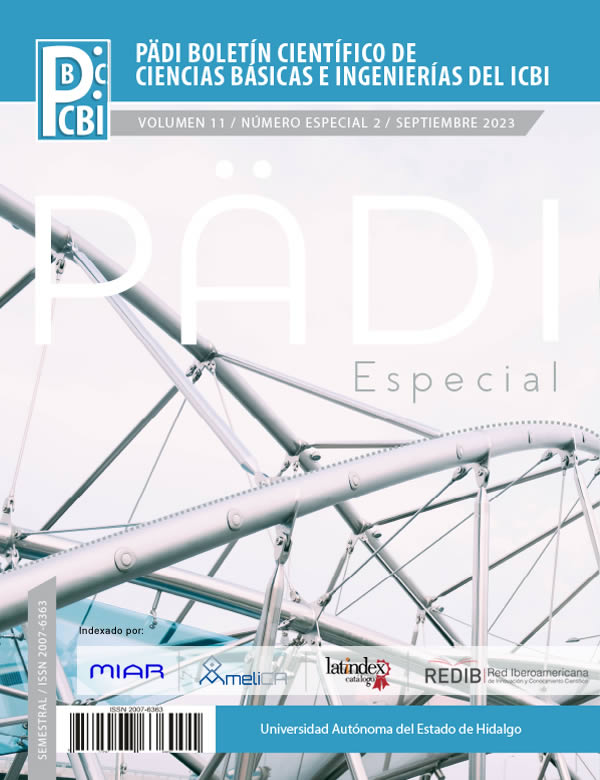Generación de trayectorias y control no lineal aplicado a vehículos móbiles con ruedas empleando Webots y vehículo autónomo Autominy
DOI:
https://doi.org/10.29057/icbi.v11iEspecial2.10878Palabras clave:
Vehículo móvil con ruedas, Generación de trayectorias de referencia, Control basado en observador, Control no linealResumen
Este artículo presenta una metodología para la generación y seguimiento de trayectorias empleando Redes Neuronales Artificiales (RNA) aplicadas en robots móbiles con llantas utilizando técnicas de control no lineales. Para la generación de trayectorias se utilizaron dos estructuras de RNA que permiten analizar el entorno donde opera el vehículo, segmentarlo y generar una trayectoria empleando un sistema de visión. Por otro lado, se estudian e implementan dos metodologías de control no lineales tanto en simulaciones numéricas como en una plataforma experimental. La primera ley de control emplea dos estados adicionales para generar un algoritmo de realimentación dinámica. Por su parte, el segundo esquema de control es un algoritmo Proporcional Integral Derivativo (PID) combinado con un observador de perturbaciones. Para verificar la efectividad de la metodología de diseño de trayectorias, así como de los algoritmos de control, se emplea el simulador Webots y, como plataforma experimental, el vehículo autónomo Autominy. Las simulaciones numéricas y los resultados experimentales demuestran la efectividad de las metodologías desarrolladas.
Descargas
Información de Publicación
Perfiles de revisores N/D
Declaraciones del autor
Indexado en
- Sociedad académica
- N/D
Citas
(2023). Autominy. AutoMiny/AutoMiny: Software stack based on ROS for the AutoMiny model cars.
(2023). Simulating your robots with webots. https://cyberbotics.com/webots, Cyberbotics.
Alomari, K., Mendoza, R., Goehring, D., y Rojas, R. (2021). Path following with deep reinforcement learning for autonomous cars. Proceedings of the 2nd International Conference on Robotics, Computer Vision and Intelligent Systems - Volume 1: ROBOVIS, SciTePress.
Dat, V., Bao, N., y Hung, P. (2022). Hybridnets: End-to-end perception network. arXiv, https://arxiv.org/abs/2203.09035, Creative Commons Attribution 4.0 International.
Davy, N., De, B. B., Stamatios, G., Marc, P., y Van, G. L. (2018). Towards end-to-end lane detection: an instance segmentation approach. 2018 IEEE Intelligent Vehicles Symposium (IV).
Fisher, Y., Haofeng, C., Xin, W., Wenqi, X., Yingying, C., Fangchen, L., Vashisht, M., y Trevor, D. (2020). Bdd100k: A diverse driving dataset for heterogeneous multitask learning. 2020 IEEE/CVF Conference on Computer Vision and Pattern Recognition (CVPR).
Hyung, L. M., Gyu, P. H., Hee, L. S., Sup, Y. K., y Soo, L. K. (2013). An adaptive cruise control system for autonomous vehicles. International Journal of Precision Engineering and Manufacturing.
Khalil, H. K. (2014). Nonlinear control. Pearson Education Limited.
Kramer, J., Scheutz, M., Kramer, J., Scheutz, . M., y Scheutz, M. (2007). Development environments for autonomous mobile robots: A survey. http://smart.informatik.uni-ulm.de/MIRO/.
Lee, M. H., Park, H. G., Lee, S. H., Yoon, K. S., y Lee, K. S. (2013). An adaptive cruise control system for autonomous vehicles. Internatioal Journal of precision engineering and manufacturing.
Liu, D., Tang, M., y Fu, J. (2022). Robust adaptive trajectory tracking for wheeled mobile robots based on gaussian process regression. Systems and Control Letters.
Lu, Q., Chen, J., Wang, Q., Zhang, D., Sun, M., y Su, C. Y. (2022). Practical fixed-time trajectory tracking control of constrained wheeled mobile robots with kinematic disturbances. ISA Transactions.
Luca, A. D., Oriolo, G., Samson, C., y Laumond, J.-P. (1998). Feedback control of a nonholonomic car-like robot robot motion planning and control feedback control of a nonholonomic car-like robot. Lectures Notes in Control and Information Sciences.
Miranda-Colorado, R. (2022). Observer-based proportional integral derivative control for trajectory tracking of wheeled mobile robots with kinematic disturbances. Applied Mathematics and Computation.
Park, J. H., Kim, S. H., y Park, T. S. (2019). Asymptotically convergent switching differentiator. International Journal of Adaptive Control and Signal Processing.
Rosas-Vilchis, A., de Loza, A. F., Aguilar, L. T., Cieslak, J., Henry, D., y Montiel-Ross, O. (2020). Trajectory tracking control for an autonomo vehicle using a decoupling approach. 2020 28th Mediterranean Conference on Control and Automation (MED).
TuSimple, A. (2022). Tusimple-benchmark. https://github.com/TuSimple/tusimple-benchmark.
Yoo, S. J. (2013). Adaptive neural tracking and obstacle avoidance of uncertain mobile robots with unknown skidding and slipping. Information Sciences.
Zequn, Q., Huanyu, W., y Xi, L. (2020). Ultra fast structure-aware deep lane detection. Computer Vision – ECCV 2020, Springer International Publishing, 276–291, available at https://github.com/cfzd/Ultra-Fast-Lane-Detection.




















